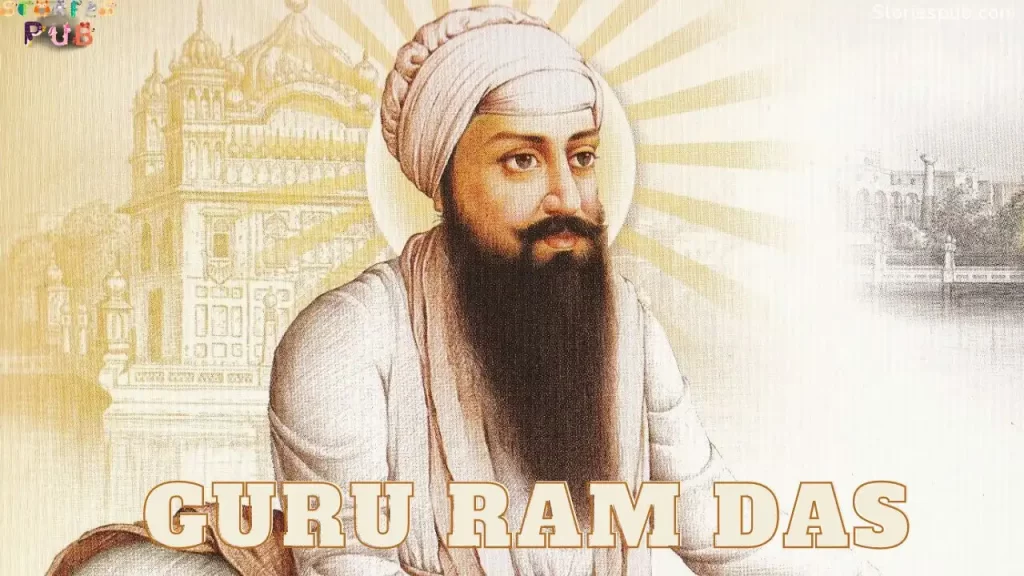Guru Ram Das (Fourth Sikh Guru) | Early life, Facts, & Death

Guru Ram Das was the fourth of the ten Sikh Gurus and played a significant role in shaping Sikhism as we know it today. Born in Lahore, Pakistan, Guru Ram Das was not only a spiritual leader but also a social reformer and builder. His contributions to Sikhism are immense, and his legacy continues to inspire millions of people around the world.
In this article, we will take a closer look at Guru Ram Das’ life, teachings, and contributions to Sikhism. We will explore his early life, his journey to becoming the fourth Sikh Guru, and his significant reforms and contributions to Sikhism. We will also examine his beliefs, famous quotes, and his legacy in modern times. Finally, we will discuss the circumstances surrounding his death and the celebration of his life and contributions.
| Guru Ram Das, Biography | |
| Full Name | Ram Das |
| Nick Name | Ramdas |
| Date of Birth | 24 September 1534 |
| Place of Birth | Lahore, Pakistan |
| Father Name | Hari Das |
| Mother Name | Anup Devi |
| Education Qualification | N/A |
| Married Status | Married |
| Wife Name | Mata Bhani (m. 1554–1581) |
| Children | 3 children, Guru Arjan, Prithi Chand, Baba Mahan Dev |
| Nationality | British Raj, Indian |
| Profession | Sikh Guru |
| Known For | founder of Amritsar city |
| Age | 47 |
| Height | N/A |
| Weight | N/A |
| Networth | N/A |
| Health Issue | N/A |
| Death Date and Place | 1 September 1581, Goindwal Sahib |
Guru Ram Das Born, Early Life, and Education
Guru Ram Das was born on September 24, 1534, in Lahore, Pakistan, to a Hindu family. He was the son he his father Hari Das, and his mother Anup Devi. Guru Ram Das’ family belonged to the Sodhi clan, which claimed descent from the founder of Sikhism, Guru Nanak Dev.
Guru Ram Das grew up in a devout Hindu family and received a traditional education. He was deeply influenced by the teachings of his family and spent much of his childhood studying Hindu scriptures and practicing meditation.
As Guru Ram Das grew older, he continued his spiritual journey and began studying under the guidance of various spiritual teachers. He learned about different religious traditions and spiritual practices, including Hinduism, Islam, and Sikhism. Eventually, he became a disciple of Guru Amar Das, the third Sikh Guru, and spent many years under his tutelage.
Under Guru Amar Das’ guidance, Guru Ram Das deepened his spiritual practice and began to gain a following of his own. He was known for his devotion and humility, and many people were drawn to his teachings. Eventually, Guru Amar Das appointed Guru Ram Das as his successor, making him the fourth Sikh Guru.
Guru Ram Das ji family, wife, and children
Guru Ram Das had a close-knit family that was deeply devoted to spiritual practice. Guru Ram Das was married to Bibi Bhani, also known as Mata Bhani. Bibi Bhani was the daughter of Guru Amar Das, and their marriage strengthened the ties between the two families. Guru Ram Das was a loving husband and father, and his family played an important role in his life and teachings.
Both couples had three sons: Prithi Chand, Mahadev, and Arjan Dev, who would later become the fifth Sikh Guru. Bibi Bhani was a devoted wife and played an essential role in supporting Guru Ram Das’ teachings and mission.
Family is an essential part of Sikhism, and Guru Ram Das emphasized the importance of strong family ties and relationships. He believed that families were the building blocks of society and that strong families were necessary for the well-being of the community. He also stressed the importance of treating women with respect and equality, and his marriage to Bibi Bhani was a testament to this belief.
What is Guru Ram Das famous for?
Guru Ram Das is famous for his contributions to Sikhism and for being the fourth Sikh Guru. He is also known for his spiritual teachings, which emphasized the importance of devotion, service, and humility.
Guru Ram Das is credited with establishing the city of Amritsar, which is considered the holiest city in Sikhism. He founded the Harmandir Sahib, also known as the Golden Temple, which is the most sacred shrine for Sikhs around the world. The Golden Temple serves as a symbol of Sikh unity and is visited by millions of people every year.
In addition to his spiritual contributions, Guru Ram Das also made significant social and political reforms. He worked to abolish the caste system and encouraged inter-caste marriages. He also established the institution of langar, a free community kitchen that serves vegetarian meals to all, regardless of caste, religion, or social status.
Journey to Becoming the Fourth Sikh Guru
Guru Ram Das had a deep connection with Guru Amar Das, the third Sikh Guru, who was his spiritual mentor and guide. Guru Amar Das recognized Guru Ram Das’ spiritual potential and appointed him as the leader of the Sikh community in Goindval.
In 1574, Guru Amar Das appointed Guru Ram Das as his successor, making him the fourth Sikh Guru. The appointment was significant as it was the first time that a Guru had appointed his successor, and it marked a significant shift in the leadership structure of the Sikh community.
Guru Amar Das’ decision to appoint Guru Ram Das as his successor was not without controversy. Many members of the Sikh community felt that Guru Amar Das should have chosen one of his sons as the next Guru. However, Guru Amar Das recognized that Guru Ram Das was the most spiritually qualified and capable person to lead the community.
Guru Ram Das’ selection as the fourth Sikh Guru marked a significant turning point in Sikh history. He continued the work of his predecessors, building on the foundations they had established and expanding the Sikh community’s reach and influence. Guru Ram Das’ teachings emphasized the importance of service, devotion, and humility, and he worked tirelessly to promote these values among his followers. His legacy continues to inspire and guide Sikhs around the world to this day.
Contributions and Reforms by Guru Ram Das
Guru Ram Das made significant contributions to Sikhism and introduced many reforms that continue to shape the religion to this day.
Guru Ram Das is credited with founding the city of Amritsar, which he established in 1577. He chose the location for the city based on the peaceful and serene surroundings, as well as the availability of a freshwater source. The city quickly became an important hub for Sikhism, and Guru Ram Das encouraged his followers to settle there.
Guru Ram Das commissioned the construction of the Harmandir Sahib, also known as the Golden Temple, which is considered the most sacred shrine in Sikhism. The temple was built in the center of a man-made lake, and its stunning architecture and gold-plated dome attract visitors from all over the world. The temple serves as a symbol of Sikh unity and is a testament to Guru Ram Das’ vision and dedication.
Guru Ram Das introduced the Anand Karaj ceremony, which is a Sikh marriage ceremony that emphasizes the importance of equality, mutual respect, and love between partners. The ceremony involves the couple taking four vows, known as the laavan, and concludes with the couple being declared as one in the presence of the Guru Granth Sahib, the holy book of Sikhism. The Anand Karaj ceremony remains an important part of Sikh wedding traditions and is celebrated with great joy and enthusiasm.
What did Guru Ram Das believe?
Guru Ram Das believed in the power of devotion, compassion, and service to others. He emphasized the importance of meditation, selfless service, and living a virtuous life. He also taught the concept of Hukam, which is the divine will of God, and encouraged his followers to submit to it with humility and grace.
Guru Ram Das Ji Famous Quotes?
Guru Ram Das left behind many inspirational quotes that continue to inspire and guide Sikhs to this day. Some of his famous quotes include:
- “Let no man in the world live in delusion. Without a Guru, none can cross over to the other shore.”
- “Serve the True Guru and find peace within; your destiny will be written with your hand.”
- “O mind, keep the Lord always in your heart. Through the Guru’s teachings, let your doubts be dispelled.”
Legacy of Guru Ram Das
Guru Ram Das’ legacy continues to inspire and guide the Sikh community today. His contributions to Sikhism, including the building of the city of Amritsar and the construction of the Harmandir Sahib, are celebrated and revered by Sikhs around the world. His emphasis on the importance of selfless service, devotion, and humility continues to be a guiding force for Sikhs as they seek to live virtuous life and serve others.
The final years of his life and his teachings
In the later years of his life, Guru Ram Das continued to emphasize the importance of service and devotion to God. He also emphasized the importance of living a virtuous life and treating all people with love and respect. One of his famous teachings was the concept of “Sewa,” or selfless service, which has become a core principle in Sikhism.
During his final years, Guru Ram Das appointed his youngest son, Guru Arjan Dev, as his successor, ensuring a smooth transition of leadership within the Sikh community. He passed away in 1581 at the age of 47, leaving behind a legacy of devotion, compassion, and selfless service that continues to inspire and guide Sikhs to this day.
Death
Guru Ram Das passed away on September 1, 1581, at the age of 47 in Amritsar, Punjab. His death was a great loss to the Sikh community, but his teachings and legacy continue to inspire and guide Sikhs around the world.
Conclusion.
Guru Ram Das was a pivotal figure in the development of Sikhism, and his contributions and reforms continue to be celebrated and revered by Sikhs around the world. He emphasized the importance of selfless service, devotion, and humility, and his teachings continue to inspire and guide Sikhs in their daily lives.
His legacy, including the building of the city of Amritsar and the construction of the Harmandir Sahib, has left an indelible mark on the Sikh community and the world at large.
Hey kids, how much did you like Guru Ram Das (Fourth Sikh Guru) | Early life, Facts, & Death? Please share your view in the comment box. Also, please share this story with your friends on social media so they can also enjoy it, and for more such biography, please bookmark storiespub.com.
Suggested Article –
- Essay on Child Labor for Students and Children
- Essay on My School for Students
- Essay on Newspaper
- Tree Essay for Students and Children
- Essay on Elephant for Students and Children in English?
- Nelson Mandela Biography







